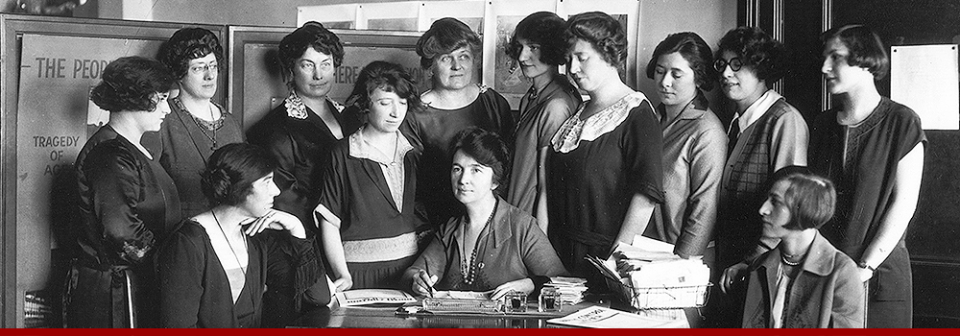
Margaret Sanger in the fall of 1920 after returning from her trip to Germany. (Courtesy of the Sophia Smith Collection, Smith College)
The newest edition of the Margaret Sanger Papers Project Newsletter includes a lead article by Peter Engelman that details Margaret Sanger’s 1920 trip to Germany. Sanger’s first international trip since she emerged as the leader of the American birth control movement was a pivotal one. As Peter wrote:
Sanger’s tour of several German cities in the summer of 1920 informed her reform work for years to come. Her insights into the plight of poor German women gave a new urgency to her belief in the need for women everywhere to define and assert their reproductive rights. Her observations of German children shaped her views on eugenics and humanitarianism. Everything she saw reinforced her faith in Malthusian theory–her understanding of how over population inevitably leads to distress and human suffering, and forces political leaders to follow a path of expansionism and war.” (Sanger’s Hunger Games-A Postwar Germany Odyssey, Fall 2012.)
It is always important to understand the context in which statements are made. The world that Margaret Sanger lived in was very different from our times. Germany after World War I was a disaster. High birth rates, high infant and maternal mortality rates, food shortages and disease plagued the nation, but hit its poor especially hard. Women’s lives revolved around the hunt for food. Sanger wrote:
The women are the sufferers. The best food must be given to the men. Charities and kind societies give the children cocoa and soup, but the mother goes without, or lives on what she can scrape together. Her life is a constant hunt for food; all her days are occupied with the problem of feeding her family. It is a terrible problem! (Margaret Sanger, “Women in Germany,” Birth Control Review, 4:12 [Dec. 1920]:9.)
Sanger described the despair of mothers watching children slowly succumb to malnutrition, likening it to torture, with “little faces growing paler, eyes more listless, little heads drooping day by day until finally they did not even ask for food” (“Women in Germany,” 9), She found the trip emotionally and physically draining and it challenged her already eroding faith in humanitarian efforts that were not coupled with contraceptive information. On her return from Germany, Sanger offered some of her most controversial statements. From the newsletter article:
“The old-fashioned warrior who entered with sword and killed his victims outright has my respect after witnessing the ‘Peace’ conditions of Germany,” she wrote shortly after leaving Europe. She aimed for shock value a few months later in a dinner speech before the Women’s Economic Club in Philadelphia, when she suggested that rather than sending aid for starving children in Germany and other European countries, the United States should “send over a quantity of chloroform to put them out of their misery,” because that would be the best thing for the children and the future of the world.” (Sanger’s Hunger Games-A Postwar Germany Odyssey, Fall 2012.)
Taking a statement like that out of the context that produced it, removes the ability to understand what Margaret Sanger was trying to do when she made it. She wanted to shock her audience as she had been shocked by the conditions in Germany; she wanted to provoke them into thinking about the bigger picture and what would really help the people of Europe. In Germany, as in the United States, Sanger had found that providing enough charity to get a family of five through the next week or the next month, merely compounded the problem when it was a family of six the next year that had to share the meager rations, and a family of seven the year afterwards. She wanted to give them the knowledge and the tools to adjust their family size to their income and ability to care for it.
For much more on Sanger’s 1920 tour, see the newsletter article, Sanger’s Hunger Games-A Postwar Germany Odyssey, Fall 2012, and Sanger’s two-part article, “Women in Germany, Dec. 1920 and Jan. 1921, Birth Control Review.
